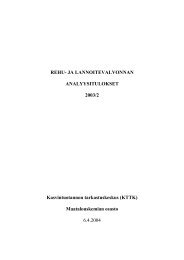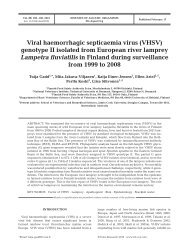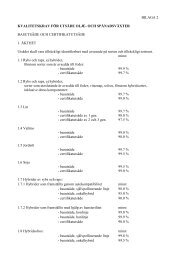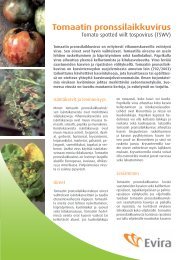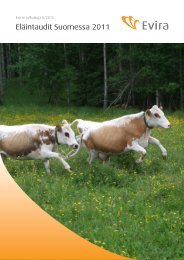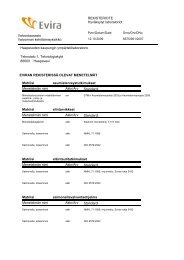Genetic characteristics of field and attenuated rabies viruses ... - Evira
Genetic characteristics of field and attenuated rabies viruses ... - Evira
Genetic characteristics of field and attenuated rabies viruses ... - Evira
Create successful ePaper yourself
Turn your PDF publications into a flip-book with our unique Google optimized e-Paper software.
group including some reference <strong>viruses</strong> from Europe was further divided into four<br />
subgroups. All the vaccine strains were clearly different from the <strong>field</strong> strains. No<br />
recombination between the <strong>field</strong> <strong>and</strong> vaccine virus strains was observed. The critical<br />
roles <strong>of</strong> geographical isolation, the limitation <strong>of</strong> the genetic clustering, <strong>and</strong> the evolution <strong>of</strong><br />
the <strong>rabies</strong> virus were shown during this study.<br />
The <strong>rabies</strong> virus vaccine strain RV-97 is widely used in Russia as a component <strong>of</strong><br />
the oral anti-<strong>rabies</strong> vaccine “Sinrab”. To characterize the molecular properties <strong>of</strong> this<br />
strain, entire genome sequencing was conducted. A simple technique was developed to<br />
obtain this sequence, including the 3’- <strong>and</strong> 5’- ends. The entire genome sequence <strong>and</strong><br />
deduced amino-acid sequences <strong>of</strong> the major viral proteins were compared with the<br />
sequences <strong>of</strong> other known fixed <strong>rabies</strong> <strong>viruses</strong>. The strain RV-97 formed a separate<br />
phylogenetic branch <strong>and</strong> seems to be more related to the group <strong>of</strong> Japanese strains. The<br />
<strong>field</strong> strains from the Caucasian group seem to be phylogenetically the nearest group to<br />
the RV-97 strain.<br />
The data shown herein makes it possible to develop molecular methods for<br />
distinguishing between the <strong>field</strong> <strong>rabies</strong> <strong>viruses</strong> from the vaccine strains for the rapid<br />
recognition <strong>of</strong> the vaccine strains that are unstable or have reverted back to their<br />
pathogenic form. The wide genetic heterogeneity verified in this study indicates that it is<br />
important to remain on permanent alert for the appearance <strong>of</strong> <strong>rabies</strong>.<br />
7



